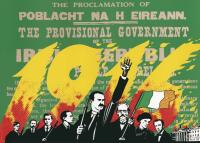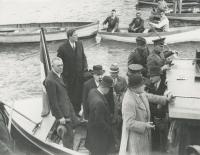On telling the Irish Revolution as it really was
Published in 20th-century / Contemporary History, Issue 5 (Sept/Oct 2012), Platform, Revolutionary Period 1912-23, Volume 20 Such well-narrated historical processes as the Roman, French and Russian revolutions allow us to identify the common traits of a revolution as distinct from a coup d’état or similar change of regime. I believe that the Irish Revolution had all these traits but that this has so far not been recognised by historians, with the result that we lack an account of the Revolution as it really was.Spelling out those traits or stages, I would describe a revolution in the following terms. A group of ideologues have a vision of a state of affairs in their political community that would be morally and materially superior to the existing one. They act to bring about that better order. Their actions have the following characteristics successively: effort to acquire the central government power; acquisition and augmentation of the central government power; cultural reform (involving moral purification and the establishment of new values and rules); missionary dissemination of the revolution’s values; completion of the revolutionary programme. (This last stage, as, for example, with collectivisation in the Russian Revolution, may take twenty or more years to occur.) As I have suggested, the Irish Revolution followed that pattern. In order to narrate it so as to make that evident, the historian would need to do a number of ancillary things, which can be enumerated as follows.
Such well-narrated historical processes as the Roman, French and Russian revolutions allow us to identify the common traits of a revolution as distinct from a coup d’état or similar change of regime. I believe that the Irish Revolution had all these traits but that this has so far not been recognised by historians, with the result that we lack an account of the Revolution as it really was.Spelling out those traits or stages, I would describe a revolution in the following terms. A group of ideologues have a vision of a state of affairs in their political community that would be morally and materially superior to the existing one. They act to bring about that better order. Their actions have the following characteristics successively: effort to acquire the central government power; acquisition and augmentation of the central government power; cultural reform (involving moral purification and the establishment of new values and rules); missionary dissemination of the revolution’s values; completion of the revolutionary programme. (This last stage, as, for example, with collectivisation in the Russian Revolution, may take twenty or more years to occur.) As I have suggested, the Irish Revolution followed that pattern. In order to narrate it so as to make that evident, the historian would need to do a number of ancillary things, which can be enumerated as follows.
Explain the situation in Ireland before the Revolution began:
In particular, among other things, that the population was divided into two ethnic–religious communities, the much larger one Catholics, the other Protestants, with the latter predominating in the north-east; the historical origins of these communities and the nature of their present relationship, including the fact that the Protestants generally were loyal to the British state, most fervently in the north-east, while the Catholics generally espoused an Irish nationalism that had two supreme values—the Irish nation (understood as consisting essentially of themselves, while open to other adherents), which they wanted to acquire liberal-democratic self-government, and Catholicism (its faith, devotions and morality), which they wanted to flourish. (A footnote here might state as follows: ‘Neither the Catholics nor the Protestants constituted a sect, and neither described matters pertaining to itself or to the other by the derogatory term “sectarian”, though Irish historians after the mid-twentieth century acquired the inaccurate and unhistorical habit of doing so.’) And, continuing the account of Ireland before the Revolution, that there was a secret society, the IRB, consisting mainly of Catholics and ramifying mainly among the Catholic nationalists, which held, and was pursuing, a single value and vision: an Irish Republic (meaning a sovereign, liberal-democratic state) comprising in fraternity all the inhabitants of Ireland, Catholic and Protestant, the latter having replaced their British allegiance with allegiance to Ireland; and finally, that there was a Gaelic-revivalist movement gathering force.
Narrate how at Easter 1916 the effort to acquire the central government power began:
In particular, among other things, that the Rising amounted to a public fusion of Republicanism (proclamation of the Irish Republic) with an overtly Catholic intention. The latter, signalled by the choice of Easter for the Rising, had been declared or intimated beforehand by several of the leaders (most explicitly by James Connolly) as an intention to redeem the Irish people through the effusion of blood, in imitation of Christ on the Cross. (Here a footnote might say: ‘A “redemption by blood”, not a “blood sacrifice”—a British term used to describe the deaths in action of British soldiers in the Great War, which was later often and erroneously ascribed to the intentions of the leaders of the Rising”.) Also, anecdotally, that on the Saturday before the Rising there were queues of young men for Confession in Dublin churches.
Narrate the War of Independence and Truce:
In particular, among other things, that the Republican leadership worked towards its vision of Catholic–Protestant fraternity in an all-Ireland sovereign state, while most of the members of the IRA and Cumann na mBan, nominally accepting the Republican goal, remained the Catholic nationalists that they had previously been, with the two above-mentioned supreme values and aims.
Narrate—following the acquisition of less-than-sovereign central government power over four-fifths of Ireland—the internal augmentation of that power:
Useful for a start would be Diarmaid Ferriter’s ‘Lovers of liberty?’ Local government in twentieth-century Ireland.

Éamon de Valera leads a government delegation to Spike Island, one of the ‘Treaty ports’, on 11 July 1938. The 1938 Anglo-Irish Agreement also ended land annuity payments—‘completing the revolutionary programme by terminating the purchase of Irish land from the landlords and attaining full sovereignty and an Irish republic in all but name’. (Irish Press)
Narrate—following the sidelining of the Republican element into political opposition—the cultural reform (involving moral purification and establishment of new values and rules):
In particular, among other things, that this process was carried out by the Catholic nationalist and Gaelic-revivalist elements of the Revolution, and that a notable feature of the moral purification was the campaign against prostitution in Dublin, where the Legion of Mary functioned as the Irish equivalent of the Interdepartmental Commission to Combat Prostitution in the Russian Revolution and, in the French Revolution, the procurator-general’s office of the Jacobin Commune. (In these cases, as in that of Augustus in the Roman Revolution, moral purification of one kind or another purported to show the moral superiority of the new regime over its predecessor.)
Narrate the missionary dissemination of the Revolution’s values:
Namely, that a great and growing Irish Catholic missionary movement started with the foundation of the Maynooth Mission to China in 1916; that many of its men and women had taken part in the War of Independence and brought, together with the Christian message, opposition to imperialism and colonialism to many African and Asian peoples, with frequent impact through missionary schools and hospitals on nascent independence movements. Here a footnote might state: ‘In view of the full treatment given to the first Irish missionary movement—that of the fifth to seventh centuries—in the standard history of Ireland, and of the inclusion of the British missionary activity of the eighteenth–twentieth centuries in standard British history, the virtual omission of this second great Irish missionary movement from the standard academic history of Ireland has been, to say the least, eccentric. An unfortunate result is that much human and written testimony to this major aspect of twentieth-century Irish history in Africa, Asia and elsewhere has been permanently lost to Irish historical research.’
Narrate the completion of the revolutionary programme in the 1930s:
In his book The evolution of Irish nationalist politics and elsewhere, Tom Garvin shows that the Irish Revolution belongs to the category of twentieth-century anti-colonial independence movements and shares the characteristics of such movements. Among these characteristics are that the movement divides, not along European left–right lines but into two wings more or less accommodating to the metropolitan power; and that, after independence is achieved, governing power in the colony is exercised initially by the more accommodating wing and subsequently by the less accommodating one. Applying this to the Irish case would show the Republican wing, tinged now with Catholic nationalism, passing in the 1930s from parliamentary opposition to government and in that role completing the revolutionary programme by terminating the purchase of Irish land from the landlords and attaining full sovereignty and an Irish republic in all but name.
The above is the merest sketch, open to amendment in detail, of what I imagine as the Irish Revolution finally receiving its deserts in historical narrative. HI
Desmond Fennell’s forthcoming book is The staggered end of Western civilisation.
















